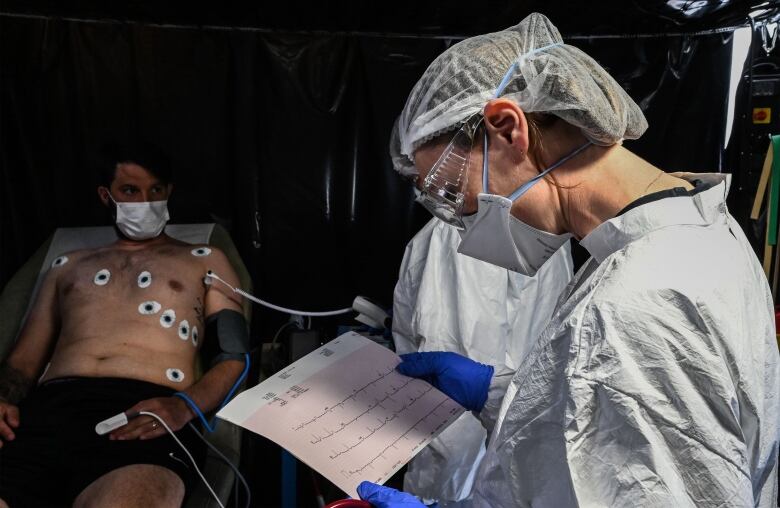In the new book ‘We Are Electric,’ Sally Adee writes about tapping into our body’s and brain’s electricity


A bit more than a decade ago, science and technology journalist Sally Adee found herself in a unique situation. She was armed with a modified M4 rifle and had an electrical brain stimulating device on her head.
It was part of a U.S. military experiment to test the ability to use electricity to supercharge soldiers’ battlefield performance.
And she could hardly believe it when researchers delivered a gentle electrical current to her scalp and, in a simulation of a military encounter, she performed like a battle-tested sharpshooter. Adee became a little obsessed with the influence that electricity can have on our brains and biology.
Over the years, it’s become increasingly clear to scientists that not only is electricity imperative for life itself, but that manipulating it can have significant impact on our mental and physical health.

This interview has been edited for length and clarity.
Take me through this sharp shooting-experience. What kind of electrical signals did that tap into your brain?
I was wearing something called a transcranial direct current stimulation (tDCS) headset, and that’s just two electrodes that are generating an electric field. And when that field is on, then according to what people thought at the time, you’re just making it more likely for neurons to fire more quickly in order to accelerate the process of learning something.
Since then, I’m not sure how much of this has been replicated because what we found out in the years since this experiment is that there are so many parameters when you’re trying to augment someone’s individual neural physiology that there are all these wild variables that you have to take into account.
For example you have to even account for the thickness of someone’s skull. So the result of that is that for some people transcranial direct current stimulation works really well and for others it doesn’t and this has been demonstrated across a range of different applications like depression, anxiety, etc.

So could you feel the difference when you put this thing on?
I did. It was extraordinary. One thing that I hadn’t been aware of before I went into this simulation was that I tend to have a contingent of wasps in my head. It’s like the supermarket music in my mind is just like negative, self-recriminating, relentless and just constantly self critical. And I had sort of gotten used to that in my life, you know. It was just this sort of feature of my brainscape.
Then when the electric current turned on, it was like somebody just stuck a bell jar over my head and insulated me from the sort of constant buzz and suddenly I was incredibly calm. And instead of ruminating on every task and how bad I was at doing, I just got on with it. Then all of a sudden that alone supercharged my expertise.
And what’s interesting about that is many years later I met a professor who studies tDCS for people who have a kind of depression that is characterized by a lot of negative self talk and that sort of ratchets up their anxiety and keeps them quite depressed. And she said that that particular intervention, tDCS, is incredibly effective at lifting their depression because it does the same thing. It just sort of short circuits their ability to undercut themselves at every turn with their wasps, you know? And that suggested to me that I got really lucky when it came to participating in this experiment because not everyone responded to that particular electrode placement.

You have a great analogy in your book that explains how the neurons send these electrical signals, and it’s similar to managing an exclusive nightclub. Tell me about that.
So bioelectricity has had this very long, contentious history, but one place it’s totally uncontroversial is in how it works in the nervous system. So the flow of electrically charged particles called ions flow into and out of neurons and controls the release of neurotransmitters, which go across the synapse. And that’s how the nervous system signal propagates throughout the body and how the brain passes signals to the limbs to move the body. It’s how the body tells the brain about the environment via sensory input.
This event is literally electric; it depends on a voltage flipping and the voltage that we’re talking about is generated by the fact that these little bouncers in your cell membrane, called “ion channels,” admit potassium and refuse to admit sodium.
While a cell is in its happy place, called its resting potential, there’s always an imbalance of ions inside, it’s very heavy on potassium. Outside, it’s very heavy on sodium. The inside of the cell is always minus 70 millivolts more negatively charged than the outside. That’s the neuron’s resting potential.

Oh, I see. The ones inside the cell are like the dancers in the nightclub having a good time and the ones on the outside are those standing in line waiting to get in.
Exactly. And they’re sort of pressing their face against the blackened windows and they’re like, how come I can’t get in?
OK and it’s the difference between those two that’s making this electric voltage you’re talking about.
Yes, exactly. And then what happens is when the action potential comes through from a neighbouring neuron, it’s panic at the disco. Like all of a sudden, all the gates open, all the sodium ions flow in, all the potassium ions flow out and the voltage difference drops to zero. And it’s that flipping between 0 and 70 millivolts which passes the action potential down the nerves to the muscles and back.
Now how prevalent are these electrical signals throughout the rest of our body, beyond the brain?
Scientists finally sort of verified the last bits of what I just told you in the 1970s, which brought bioelectricity legitimately into the fold of science and after they discovered this in neurons, they started looking at other cells and discovered that other cells have these same ion channels in them. Bone cells, plant cells, fungal cells and stem cells, everything has ion channels. And when they started to understand that every cell is a little battery at the level of the membrane.

One area that it’s used in is wound healing. When you cut your skin, all the ions that are in the skin cells that are normally doing very orderly things, they leak out. It’s like a short circuit, like if you cut an electrical wire when you cut the skin.
All these ions leak and they flow all over the place and this generates this thing called the “wound current.” And the wound current makes an electric field and this electric field that acts like a beacon. It’s like a homing signal for repairing cells and cleaning up. Cells like macrophages come in and mop up the mess and start to do the actual sort of repairs to build up the scar tissue to heal your wound.
Over the past couple of decades, people have become much more interested in this because by messing with the ion channels in the skin cells, you can slow down this healing because you’re messing with the wound current. With electrical stimulation, it looks like you can speed it up.
They’re now trying to figure out how they could perhaps use it to help heal chronic non-healing wounds like diabetic foot ulcers.

So what’s the potential impact on our health, like the battle against cancer?
Yeah, well, this is super interesting. I think there is a lot of correlational evidence that’s starting to look at cancer as being something that may be manipulable with bioelectric signals. Stem cells have a voltage that’s close to zero as these cells differentiate and become mature sort of participating members of society, if you will.
Nerve cells are minus 70 millivolts. Musculoskeletal tissue, a much more robust minus 90. Fat cells, slightly wobbly, are minus 50. Liver cells, minus 40. So what I’m saying is cells have this electrical identity that they grow into, but what’s really interesting is that if a mature cell decides that it’s going to abandon ship and it’s like, ‘I don’t care, I’m going to turn into a ravenous cancer cell.” When they become cancerous, their electrical identity drops back towards 0.
And so that was a really interesting observation that led the researchers to start investigating what would happen if you made it so that the cells couldn’t go back to 0.

This is early days and I don’t want to have people thinking that we’ve cured cancer, but basically they were able to do it in tadpoles that had been genetically engineered to have tumours, right? Just by keeping the ion balance so that these cells could not go to 0 from their electrical identities, they were able to keep many of these tadpoles from getting these tumours even though they were genetically predestined to get the tumours.
A researcher from Tufts University even took this one step further by reversing the cell voltage from zero back to a healthy state, he was able to take actual tumour cells and almost flip an undo switch on them. It was a really astonishing experiment.


